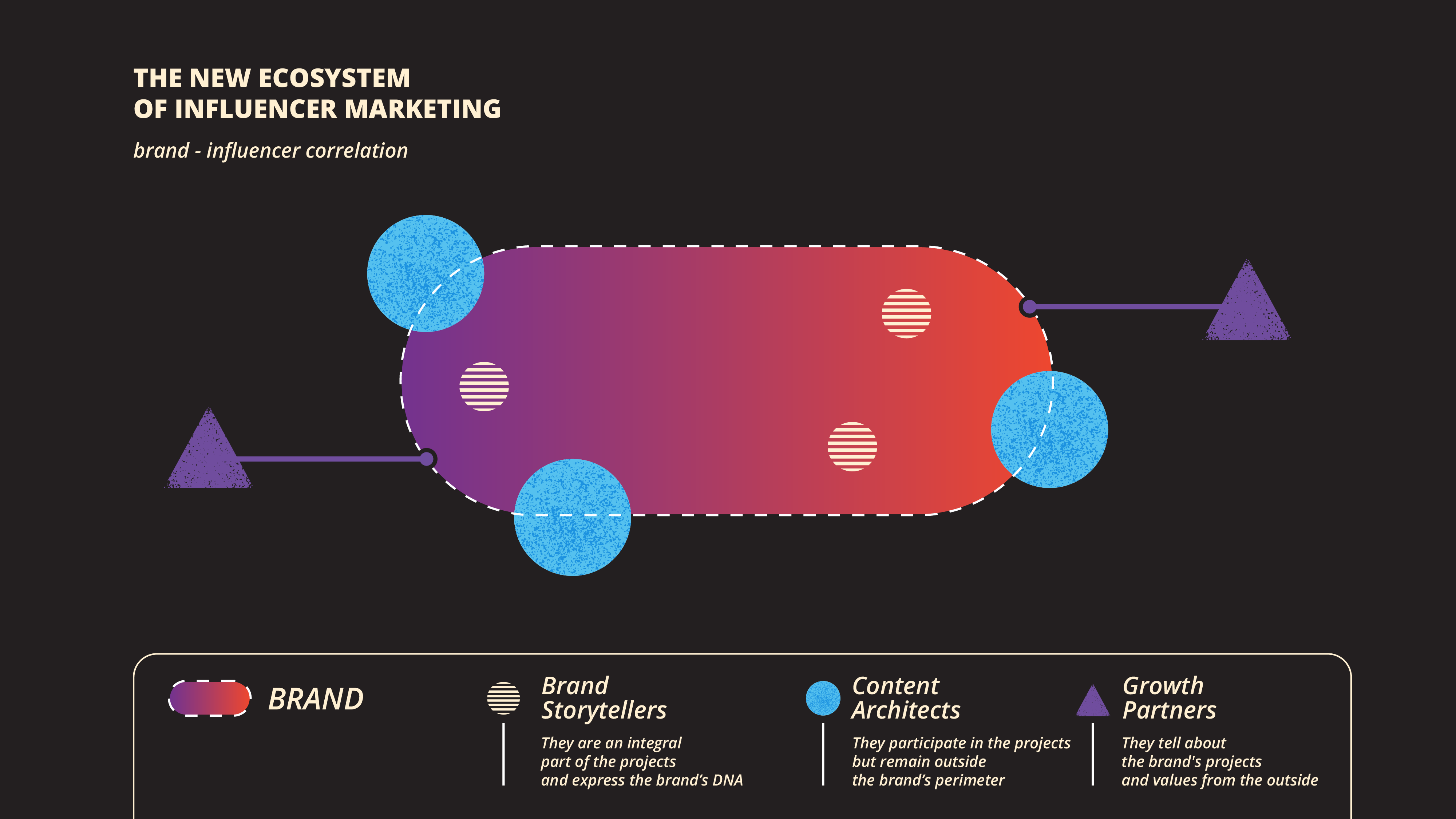bor
Creative Authenticity in Influencer Marketing
How brands can stand out through dynamic strategies and collaborative content
In recent years, influencer marketing has experienced unprecedented expansion. According to research from Marketing Hub, the global influencer marketing market is valued at $21 billion, with 300 million people worldwide identifying as content creators. This trend underscores the crucial role of creators and influencers in engaging and communicating with the audience. However, the industry’s rapid evolution brings new challenges, requiring companies to engage in ongoing strategic reflection to navigate and capitalize on emerging opportunities.
Balancing saturation and deinfluencing: navigating market contradictions
Despite its effectiveness, influencer marketing comes with challenges; market saturation has made it increasingly difficult for brands to stand out and differentiate themselves. Moreover, the risk of collaborations with influencers who employ questionable practices such as buying fake followers, manipulating engagement data, or using misleading storytelling that builds narratives suggesting beneficial or socially responsible outcomes behind promotional actions is on the rise. Recent scandals involving public figures like Chiara Ferragni [1] and well-known brands like L’Oréal with the beauty influencer Mikayla Nogueira [2] or Huda Beauty [3], have undermined trust in the sector. Such events have exacerbated distrust towards influencers, contributing to the rise of the phenomenon known as deinfluencing, especially among younger audiences who often perceive traditional marketing as inauthentic.
Deinfluencing, with its critique of marketing excess and lack of authenticity, has added an additional layer of complexity to the influencer marketing landscape. This movement pushes companies to reevaluate their strategies, exploring new forms of engagement and creativity to address an increasingly skeptical audience.
The rise of nano and micro-creators: champions of authenticity
Many companies are shifting their focus toward nano and micro-creators in response to these challenges. These influencers, with smaller but highly engaged followings, are able to foster a deeper connection with their audience something that mega-influencers often struggle to achieve. Major brands like L’Oréal [4] and Coca-Cola [5] are investing in advanced technologies to identify and collaborate with these creators. These technologies include social media analytics platforms and monitoring software capable of providing both qualitative and quantitative data, enabling not only more effective and targeted campaign management but also a more careful scouting of selected profiles.
Nano and micro-creators are often more skilled at generating authentic engagement due to their personal interaction with followers. This direct and genuine connection makes their content particularly effective at building trust and credibility. In an era where authenticity has become a core value, these creators are a valuable asset for companies seeking deeper, more meaningful relationships with their audience.
As transparency becomes an essential value, nano and micro-creators are emerging as the true leaders of the authenticity revolution.
Embracing a new era of creativity: staying fluid to embrace change
In today’s media ecosystem, creativity is no longer just a tool for capturing attention: it has become a force that must constantly evolve, adapting to languages and dynamics that often emerge spontaneously on rapidly changing digital platforms. Visibility alone is no longer enough; brands need to leave a lasting impression that connects naturally and authentically with people. Moreover, the content saturation demands higher quality standards and the ability to produce messages that truly resonate with the audience.
Creativity today isn’t just about the message it’s about the ability to immerse oneself in the fluid context in which that message comes to life. It means being flexible and ready to respond to real-time changes while consistently aligning with the brand’s values, turning every interaction into a meaningful experience.
In this new era, true innovation lies in the ability to strike a balance between content creators’ creative improvisation and a consistent, memorable brand narrative.
Companies must invest in content that communicates their brand values and reflects their unique personality and distinctive tone. Content creation has become an opportunity to forge an authentic and unforgettable brand identity, moving beyond mere visibility to create a lasting impact. Even when collaborating with influencers, it’s crucial that the content aligns with the brand’s identity and values, ensuring consistency and quality in communication.
Openknowledge’s strategic approach
In a landscape where influencer marketing is evolving unprecedentedly, mere visibility is no longer enough. We believe the future of successful strategies lies in an approach that combines authentic creativity, narrative consistency, and a sophisticated ability to adapt to new digital languages. In this new era, it’s essential for brands to tell their story and live their values through every interaction, leveraging the power of data and the agility of creators to build deep and memorable connections with their audience.

To stay relevant, brands must adopt a strategic and integrated approach to influencer marketing. Here are three key paths that offer opportunities for growth and differentiation:
Growth Partners: Collaborating with influencers beyond the brand’s immediate scope to grow together.
One option is to identify and collaborate with nano and micro-creators who operate outside the direct sphere of the brand but share similar values and characteristics. This approach requires a careful selection of creators who can tell the brand’s story in an authentic and engaging way. With their smaller but highly engaged followings, Nano and micro-creators can create content that resonates deeply with their audience. For example, brands like Nike [6] and Patagonia [7] have already adapted their strategies by shifting part of their investments toward niche creators who can generate more authentic, long-term conversations.
It’s crucial to leverage tools and technologies that measure the Return on Value (ROV) and track the impact of collaborations to optimize the approach. Analytics platforms and monitoring software are essential for facilitating the selection, management, and coordination of creators, ensuring an integrated process from choosing creators to measuring results.
Content Architects: develop long-term partnerships with influencers outside the brand's sphere but within the content.
Another strategy is to build long-term collaborations with external influencers and Key Opinion Leaders (KOLs) who have a deep understanding of the content. These creators, such as doctors or professionals in the pharmaceutical sector, can offer an authentic and credible perspective.
An example is Angelini Pharma, which collaborates with industry experts to develop content on mental health, engaging medical storytellers to address complex topics with an expert and credible voice [8]. This approach enriches the brand’s content and builds a lasting relationship of trust, though it requires careful management to maintain freshness and innovation.
Another effective example of this approach is Zenzero, the network created by GialloZafferano [9], which has developed a talent network in the food sector, producing specialized content for specific market niches. This strategy has strengthened the brand’s authority in a highly competitive sector while ensuring a consistent and distinctive voice.
Brand Storytellers: empowering influencers already within the brand’s sphere.
The third approach, perhaps the most innovative and authentic, focuses on internal brand influencers. This means identifying individuals within the organization who have the skills and inclination to become true brand ambassadors. These internal influencers live the brand daily and are uniquely positioned to tell its story credibly and authentically, drawing on their personal and professional experiences.
This approach, therefore, enables the brand to invest in a valuable and often overlooked resource: its own people. Through empowerment initiatives, these creators can be trained to use digital platforms confidently and effectively, amplifying the brand’s messages both inside and outside the company.
For example, while working on the editorial plan for the Instagram channel of La Galleria BPER Banca, we found that the posts with the highest engagement featured the individuals responsible for the public opening of BPER Banca’s corporate collection, the development of exhibitions in its gallery spaces, and the cultivation of cultural partnerships. These individuals were able to step forward and share their perspectives authoritative viewpoints from those who live the evolution of the project firsthand, understand the brand context, and communicate it clearly and effectively to the audience.
This strategy offers numerous advantages: it strengthens employees’ sense of belonging and corporate culture while offering the external audience authentic content, helping to build a transparent and trusted brand image.
The importance of an integrated approach
Every brand has a unique journey to follow, and the challenge today is not only to choose one of the paths described but also to combine them strategically. Investing in external and internal creators is essential, but leveraging internal human capital can provide a deeper and more authentic narrative.
Our approach focuses on guiding brands toward a marketing model that values the right balance between traditional and innovative strategies, integrating the skills of external creators with the potential of internal talent. To ensure that team members can become authentic brand ambassadors, it is important to create empowerment pathways that connect them deeply with the languages and trends of digital platforms.
In a context characterized by constantly changing trends such as the recent podcast boom providing ongoing training and support helps employees stay ahead, mastering new tools and channels. This involves adapting skills to technological changes and developing a deep understanding of emerging dynamics and audience expectations.
Investing in one’s people and the quality of content allows brands to emerge with a distinctive and credible voice. Authenticity makes the difference in an ocean of content: it resonates, connects, and endures.
Sources
- Balocco-Ferragni: all the stages of the ‘Pandoro gate
- In January 2023, Nogueira posted a sponsored review of L’Oréal’s Telescopic Lift mascara on TikTok. In this video, she praised the mascara’s results, but many users noticed she appeared to be wearing false lashes, accusing her of deceiving her followers. Despite the influencer denying the use of fake lashes, the video sparked a mass reaction, with many questioning the authenticity of reviews and transparency in brand-influencer partnerships.
- Huda Kattan, founder of Huda Beauty, became embroiled in controversy when it emerged that some reviews of her products may have been manipulated. Many fans accused the brand of soliciting positive reviews by sending free products and not accepting negative criticism.
- L’Oréal Paris ups influencers but admits convincing the board has been “difficult”
- How Coca-Cola identifies and engages influencers
- How Nike revolutionized marketing through influencer partnership
- Micro-influencers: the new powerhouses of marketing
- Reference LinkedIn post
- È nata Zenzero, la talent agency dei migliori food creator italiani
Authors
Marta Cioffi e Massimo Tanganelli

 11 October 2024
11 October 2024
